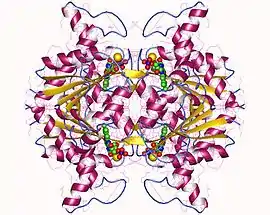NAD(P)H dehydrogenase (quinone)
In enzymology, a NAD(P)H dehydrogenase (quinone) (EC 1.6.5.2) is an enzyme that catalyzes the chemical reaction
- NAD(P)H + H+ + a quinone NAD(P)+ + a hydroquinone
| NAD(P)H dehydrogenase (quinone) | |||||||||
|---|---|---|---|---|---|---|---|---|---|
 NAD(P)H dehydrogenase (quinone) tetramer, Brucella abortus | |||||||||
| Identifiers | |||||||||
| EC number | 1.6.5.2 | ||||||||
| CAS number | 9032-20-6 | ||||||||
| Databases | |||||||||
| IntEnz | IntEnz view | ||||||||
| BRENDA | BRENDA entry | ||||||||
| ExPASy | NiceZyme view | ||||||||
| KEGG | KEGG entry | ||||||||
| MetaCyc | metabolic pathway | ||||||||
| PRIAM | profile | ||||||||
| PDB structures | RCSB PDB PDBe PDBsum | ||||||||
| Gene Ontology | AmiGO / QuickGO | ||||||||
| |||||||||
The 4 substrates of this enzyme are NADH, NADPH, H+, and quinone, whereas its 3 products are NAD+, NADP+, and hydroquinone.
This enzyme belongs to the family of oxidoreductases, specifically those acting on NADH or NADPH with a quinone or similar compound as acceptor. The systematic name of this enzyme class is NAD(P)H:quinone oxidoreductase. Other names in common use include menadione reductase, phylloquinone reductase, quinone reductase, dehydrogenase, reduced nicotinamide adenine dinucleotide (phosphate,, quinone), DT-diaphorase, flavoprotein NAD(P)H-quinone reductase, menadione oxidoreductase, NAD(P)H dehydrogenase, NAD(P)H menadione reductase, NAD(P)H-quinone dehydrogenase, NAD(P)H-quinone oxidoreductase, NAD(P)H: (quinone-acceptor)oxidoreductase, NAD(P)H: menadione oxidoreductase, NADH-menadione reductase, naphthoquinone reductase, p-benzoquinone reductase, reduced NAD(P)H dehydrogenase, viologen accepting pyridine nucleotide oxidoreductase, vitamin K reductase, diaphorase, reduced nicotinamide-adenine dinucleotide (phosphate) dehydrogenase, vitamin-K reductase, NAD(P)H2 dehydrogenase (quinone), NQO1, QR1, and NAD(P)H:(quinone-acceptor) oxidoreductase. This enzyme participates in biosynthesis of steroids. It employs one cofactor, FAD. At least one compound, Dicumarol is known to inhibit this enzyme.
Structural studies
As of late 2007, only one structure has been solved for this class of enzymes, with the PDB accession code 2F1O.
References
- Di Prisco G, Casola L, Giuditta A (1967). "Purification and properties of a soluble reduced nicotinamide-adenine dinucleotide (phosphate) dehydrogenase from the hepatopancreas of Octopus vulgaris". Biochem. J. 105 (2): 455–60. doi:10.1042/bj1050455. PMC 1198331. PMID 4171422.
- GIUDITTA A, STRECKER HJ (1961). "Purification and some properties of a brain diaphorase". Biochim. Biophys. Acta. 48: 10–9. doi:10.1016/0006-3002(61)90509-1. PMID 13705804.
- MAERKI F, MARTIUS C (1960). "[Vitamin K reductase, preparation and properties.]". Biochem. Z. 333: 111–35. PMID 13765127.
- Misaka E, Nakanishi K. "Studies on menadione reductase of bakers' yeast. I. Purification, crystallization and some properties". J. Tokyo. Biochem.: 465–471.
- WOSILAIT WD (1960). "The reduction of vitamin K1 by an enzyme from dog liver". J. Biol. Chem. 235: 1196–201. PMID 13846011.
- Sparla F, Tedeschi G, Trost P (1996). "NAD(P)H:(Quinone-Acceptor) Oxidoreductase of Tobacco Leaves Is a Flavin Mononucleotide-Containing Flavoenzyme". Plant Physiol. 112 (1): 249–258. doi:10.1104/pp.112.1.249. PMC 157943. PMID 12226388.
- Braun M, Bungert S, Friedrich T (1998). "Characterization of the overproduced NADH dehydrogenase fragment of the NADH:ubiquinone oxidoreductase (complex I) from Escherichia coli". Biochemistry. 37 (7): 1861–7. doi:10.1021/bi971176p. PMID 9485311.
- Jaiswal AK (2000). "Characterization and partial purification of microsomal NAD(P)H:quinone oxidoreductases". Arch. Biochem. Biophys. 375 (1): 62–8. doi:10.1006/abbi.1999.1650. PMID 10683249.
- Li R, Bianchet MA, Talalay P, Amzel LM (1995). "The three-dimensional structure of NAD(P)H:quinone reductase, a flavoprotein involved in cancer chemoprotection and chemotherapy: mechanism of the two-electron reduction". Proc. Natl. Acad. Sci. U.S.A. 92 (19): 8846–50. Bibcode:1995PNAS...92.8846L. doi:10.1073/pnas.92.19.8846. PMC 41064. PMID 7568029.
